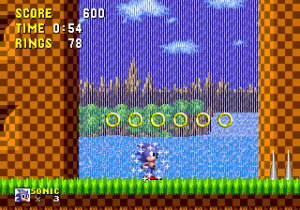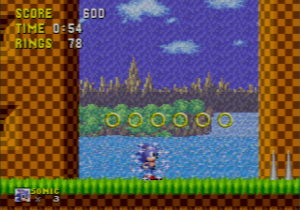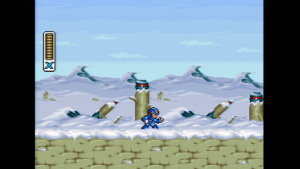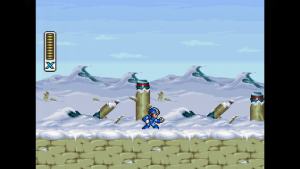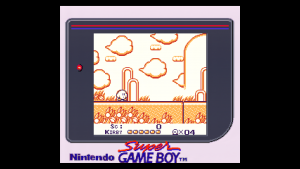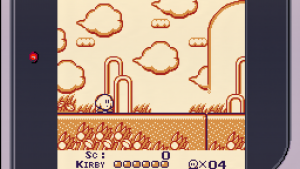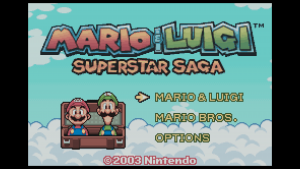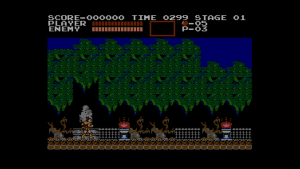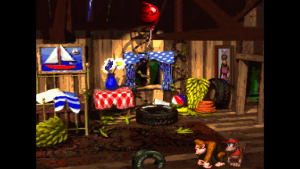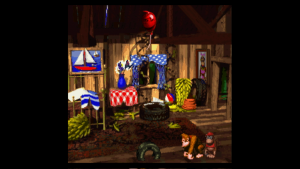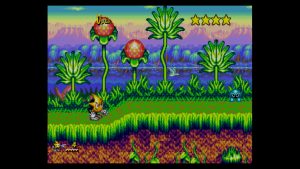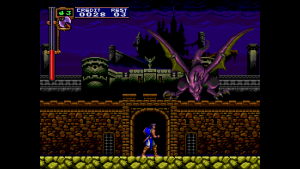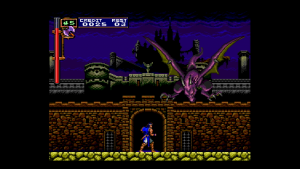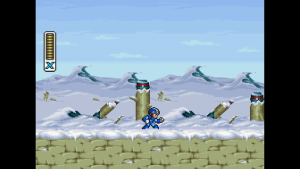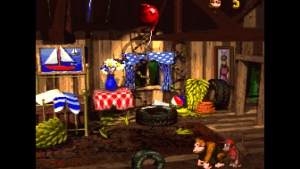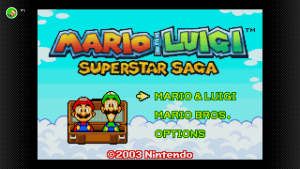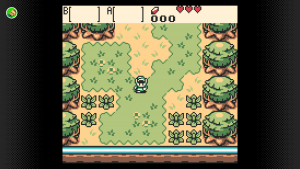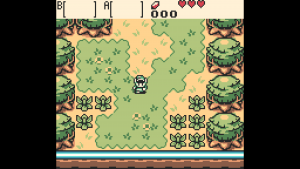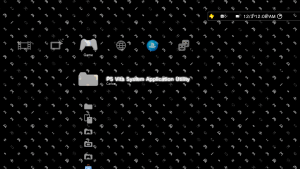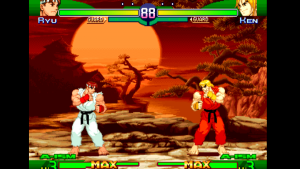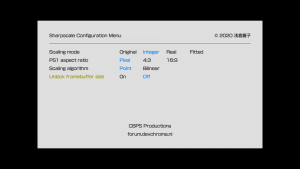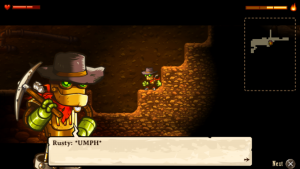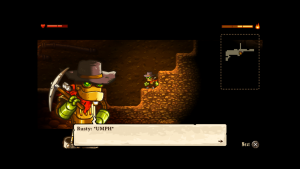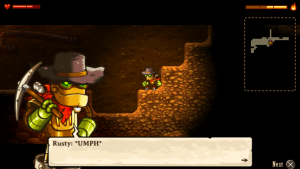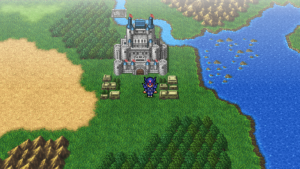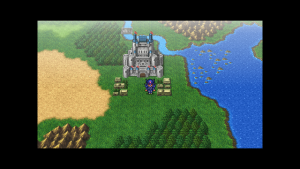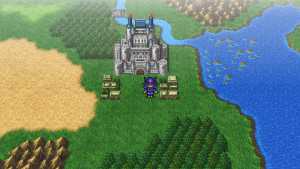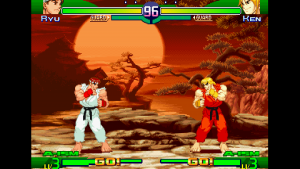AV:RetroTINK-4K/System Specific Settings
The System-Specific Settings page is all about highlighting how you can use the RetroTINK-4K's various features to improve the experience of using your video game systems beyond just plugging them in. This can range from setting 1:1 pixel aspect ratio for Super Game Boy on the SNES, to dovetailing with the Sharpscale Plugin on the PlayStation TV. While the RT4K will always provide a great experience right out of the box, the tips in this section will help remove quirks and annoyances from the original platform, or present the games more accurately.
For general information about the RT4K, please visit this page.
Defeating Dithering
Dithering is a technique many games used in tandem with the blurring effect of a video cable (like Composite) and a CRT. The idea is that the video cable and display blend the dither patterns together, to accomplish tricks like transparency or higher color depth. When using high-quality cables like RGB-SCART and Component, dithering can become very apparent, and many users may find them unsightly. The RetroTINK-4K has an option that can help:
- Go to Advanced Settings > Processing / Effects, then set Hori. Kernel and Vert. Kernel to "Bilinear Soft" as needed. This blurs the edges of the pixels to disguise the dithering.
The cost of applying this effect is that the image will of course be rather blurry. Adding some scanlines (also in the Processing / Effects menu) can help alleviate this somewhat; don't forget that HDR will help brighten the image back up. If the dithering is only vertical stripes (like the waterfalls in Sonic the Hedgehog or the water in Kirby's Dream Land 3), you could alternately use Bilinear Sharp on the Hori. Kernel, for a slightly sharper appearance.
Nintendo Systems
NES / Famicom
The Famicom (or Family Computer) is the original Japanese version of Nintendo's landmark console, while the NES (or Nintendo Entertainment System) was released in all other regions. All Famicom / NES systems will be marked as such on the front, so simply read that to tell which one yours is (particularly useful regarding the top-loading redesigns). These systems render games in 256x224.
- The NES family renders and outputs all audio in mono via the white RCA jack (left speakers). To account for this, go to Advanced Settings > Audio Setup, then set Input Swap to "Mono (Left)".
- Some NES family games, like Super Mario Bros. 3, have visual errors visible on the left and right sides of the screen. These can be removed from view using the cropping tools.
The NES / Famicom can only output either Composite video or RF (with one rare exception). You will need at least a composite signal to connect directly to the RT4K. Use the list below to tell which one your system outputs:
- Composite signals are supported by the RetroTINK-4K. This can be used on either the front yellow plug, or the rear green plug.
- Original "Front-loading" NES (NES-001).
- Top-loading "AV Famicom" with the rounded power switch and flat cartridge slot.
- Sharp's "Twin Famicom".
- Sharp's "Famicom Titler" (also capable of S-Video).
- RF signals are not normally supported by the RetroTINK-4K. These models support RF output:
- Original Famicom w. hard-wired controllers.
- Revised "Top-loading" NES with a rounded cartridge slot and power switch.
- The RF Modulator output from the original "Front-loading" NES-001, which has softer sound compared to the the sharper Composite output.
Super NES / Super Famicom
| Sample Rate Detection | ||
|---|---|---|
| Auto Dec. Factor | Yes | |
| Audo Dec Phase | Yes | |
| ADC Sample Rate | 3410 | |
| Progressive Detection | 341.000 | 682.000 |
| Manual Sample Detection (256) | ||
| RGB/Component ADC Setup (256) | ||
| Samples per Line | 3410 (2861 Act) | |
| Decimation Factor | 10 (341.000) | |
| Scaling/Crop Setup (NTSC 256) | ||
| Top Trim | -8 | |
| Bottom Trim | -8 | |
| Left Trim | -16 | |
| Right Trim | -14 | |
| Manual Sample Detection (512) | ||
| RGB/Component ADC Setup (512) | ||
| Samples per Line | 3410 (2861 Act) | |
| Decimation Factor | 5 (682.000) | |
| Scaling/Crop Setup (NTSC 512) | ||
| Top Trim | -8 | |
| Bottom Trim | -8 | |
| Left Trim | -31 | |
| Right Trim | -29 | |
The majority of Super NES / Famicom games run in 256x224 resolution, while a select few games run with a mix of the following: 512x224 in the whole screen for menus, 256x224 for most of the image while running 512x224 over certain parts of the screen to create transparency effects, or the same but using 512x224 resolution to allow sharper text on the screen. It is recommended to run the Super NES in 512x224p mode to make sure you get all available detail.
[pending screenshots of Trials of Mana or Kirby game with 512 mode vs 256 mode]
This topic is a WIP, please see the same topic on the RT5X wiki
(https://consolemods.org/wiki/AV:RetroTINK-5X_Pro#512_%22Hi_Res%22_Games)
We recommend using a Super NES model number SNS-001, or Super Famicom model number SHVC-001, and an RGB SCART cable wired for Sync-on-Luma, as this works with both of the aforementioned models. There are internal revisions of these models, noted as "1-Chip" on the motherboard, and the 1-Chip-03 does not work with Composite Sync. There is a revised model, SNS-101 and SHVC-101, also known as the Super Nintendo Junior. This model only supports composite video.
As noted, there are revisions of the original model Super NES, noted by the "1-chip" on the motherboard. The 1-chip boards have sharper yet brighter video, while the non-1-chip boards have a "smeared" and slightly darker look. We encourage using the auto-gain functions in the ADC to correct the video on both models.
Profile included for automatic switching between 512 and 256 in Display Aspect Ratio, for both SCART and HDRV YPbPr cables.
Super Game Boy
| RGB/Component ADC Setup | |||
|---|---|---|---|
| Samples Per Line | 3410 (2861 Act.) | ||
| Decimation Factor | 10 (341.000) | ||
| Scaling/Crop Setup | |||
| Top Trim | -8 | ||
| Bottom Trim | -9 | ||
| Left Trim | -16 | ||
| Right Trim | -14 | ||
| Aspect Correction | 1:1 (Sq. Pixel) | ||
| Scaling Mode | Auto Fill Integer or Proportional | ||
The Super Game Boy Cartridge allows you to play original style Game Boy and Game Boy Color cartridges on your TV using the Super Nintendo, and adds borders. Once dialed in, Game Boy games are rendered in a 160x144p window inside a 256x239p canvas. However, Game Boy games were expected to be displayed on the square pixels of their screens, unlike the rectangular CRT pixels that the SNES expects.
- For correct Super Game Boy pixels, go to Advanced Settings > Scaling/Cropping, then set Aspect Correction to "1:1 (Sq. Pixel)".
Profile included to maximize the Game Boy window to the screen, or 15x the original GB pixel count.
Nintendo 64
Unfortunately, no stock Nintendo 64s support RGB without modding. All stock N64s support Composite, all NTSC N64s support S-Video, French N64s support SECAM S-Video, and some PAL N64s do not support S-Video at all.
All N64s have 3 levels of video processing that keep it from being as sharp as the PlayStation and Saturn:
- All games scale their image to 640 pixels wide. Many games were rendered at different resolutions but the N64 will scale to 640.
- Many games render at 320 pixels wide and, as a trick, you can double your ADC Decimation factor to "correctly" render games in their original resolution. This trick only works for games that render at 320 pixels wide, and do not work for games that render at other resolutions that are not 320 or 640 pixels wide.
- Software level anti-aliasing. This can be disabled by patching ROMs or using a Gameshark to disable the effect.
- Hardware level anti-aliasing. This can't be disabled without a physical mod.
[Picture Here: AA enabled vs AA disabled]
[Picture Here: a 320 game with the trick used vs left at 640 (should be the same)]
[Picture Here: a non-640 or 320 game with the trick used (should look worse)]
Pokemon Stadium Game Boy Tower
Pokemon Stadium's Game Boy Tower allows you to play Pokemon games on your TV, similar to a Super Game Boy, and even uses the Super Game Boy borders. The issue, however, is the scaling noted above. These games render at 160x144p inside a 256x239p canvas, which is then scaled to 640 pixels wide. You will not get a sharp picture out of this setup due to that factor alone. It is recommended to play in a generic or default profile.
[Picture Here: SGB vs Pokemon Stadium]
Nintendo GameCube
For the purposes of use with the RetroTINK-4K, it is highly recommended to use a DOL-001 GameCube, which has the digital out port, and an Insurrection Industries Carby which outputs crisp digital video and can connect to the HDMI® input port of the RT4K. If you insist on buying YPbPr cables, we can only recommend the OEM D-Terminal cable with a D-Terminal to Component adapter, or the OEM component cable.
Most GameCube Games will run at 480p, a progressive mode is activated by holding B when the GameCube boots up a game.
Swiss, the Anti-Flicker Filter, and Horizontal Frame buffer Width
While Most GameCube games run at 480p and progressive mode is relatively easy to access, many GameCube games use an "anti-flicker-filter" by default, which will soften the image. Most of these filters can't be turned off in-game, but the homebrew software Swiss will allow you to boot games, including your own disks, with the anti-flicker filter turned off. As an added bonus, newer versions of Swiss automatically turn the filter off and boot your game in 480p.
[Picture Here: game with anti-flicker filter on vs off]
[Video here: Smash Bros Melee turning the flicker filter on and off]
A few GameCube games scale their image to fit the console's frame buffer before output. Swiss allows you to turn this off and shows the image at its original framebuffer width, and you can use the RT4K to scale it back, for a small sharpness gain.
[picture here: Framebuffer width left alone and the framebuffer width option turned on, with the RT4K used to scale back to the intended resolution] (I don't know what game to use)
240p Games
There are two GameCube games that run at 240p: Megaman X Collection, and the NES games in the Zelda Collector's Edition Promotional Disc. This means you do not have to enable 480p to run those games and can sharply scale these games on the RT4K.
[Picture Here: Megaman X on Super NES vs GameCube]
Game Boy Player + Game Boy Interface
| HDMI Output | |||
|---|---|---|---|
| Sync Lock | Gen | ||
| HDMI® Receiver | |||
| Input Pixels | 2 (Output: 240p) | ||
| 4:2:2 Upsampler | Nearest | ||
| Input Range | RGB Lim. | ||
| Scaling/Crop Setup | |||
| Vert Prescale | 1/2 | ||
| Aspect Correction | 1:1 (Sq. Pixel) | ||
| Scaling Mode | Auto Fill Integer | ||
| Color Correction Setup | |||
| Input Factor | 2.4 | ||
| Output Factor | 2.4 | ||
| Bit Crush | 3 bits Removed | ||
The Game Boy Player is a popular add-on to the GameCube that allows you to play Game Boy, Game Boy Color, and Game Boy Advance games on your TV. The Game Boy Player Disk does not sharply render games onto the screen, but you can use the homebrew software Game Boy Interface to sharply render games into the RT4K. A specific flavor of GBI was created to take advantage of the Insurrection Industries Carby and the TINK 4K's HDMI® Input. Please use files gbihf-rt4k-HDMI.cli, gbihf-rt4k-HDMI.dol+cli or gbihf-rt4k-HDMI.gci included with GBI and follow the instructions noted here.
Profiles included for 13x scaled GBA games and 15x scaled GBC games.
GameCube GCVideo Based HDMI Devices (Carby, GCDual, etc.) settings:
These are some recommended settings. This may not be the best for all use cases but will yield crispy results on default Tink4k profile. Also please remember to select "Store Settings" in the GCVideo menu to save your settings or not.
Carby/GCDual firmware 3.1
- Output Settings:
- Allow 480p Mode: On
- Enhanced DVI Mode: On (or else there won't be audio)
- Display as 16:9: Off (off for 4:3 or on depending if your game has a widescreen mode)
- View all Modes:
- 240p, 288p, 480i, 576i Linedoubler: Off (Let's the Tink4k handle all upscaling and deinterlacing)
- Advanced Settings:
- Fix Resolution: Off/On (Depends on more specific Tink4k profiles, default for this case is off)
- Digital Color Format: YC422 (This matches what the GameCube internally uses)
Nintendo Wii
| RGB/Component ADC Setup | |
|---|---|
| Samples per Line | 3432 (2880 Act.) |
| Decimation Factor | 4 (858.000) |
| RGB/Component ADC Setup | |
|---|---|
| Samples per Line | 3456 (2880 Act.) |
| Decimation Factor | 4 (864.000) |
The Nintendo Wii is a very versatile console: it plays GameCube Games, Wii Games, and many classic retro titles through emulators as part of the Virtual Console lineup. The Wii also has easy to find YPbPr component cables and can easily support 480p across all Wii software through its component cables, making it a popular option for playing GameCube games. The Wii only supports 3 resolutions: 720x240p, 720x480i, and 720x480p. Please read on for more information on getting the sharpest possible picture from a Wii.
Profile included for basic generic output. It is recommended you use this for basic Wii use.
Virtual Console
Many Virtual Console games output at 240p when the Wii is in SDTV mode, and they will line double to output at 480p in EDTV mode. All virtual console games scale the image to 640 pixels wide, so it is recommended you use the default or generic profiles for playing virtual console games. Also of note: NES Virtual console games are rendered many shades darker than an original console, as an anti-epilepsy measure.
| Original Console Optimized | Virtual Console Default Settings |
|---|---|
| [pending Screenshot
Castlevania NES] |
|
| [Pending Picture of Ristar on Genesis 10x DAR] | |
| NEO GEO Game | NEO GEO Game |
USBLoader GX, and Counteracting the Anti-Flicker Filter, 480p LPF, and the Framebuffer Video Width
Homebrew called USBLoader GX allows you to activate or deactivate code before running games, even on your disks.
Most Wii games will apply an anti-flicker filter, even at 480p, which results in a softer picture. Use USBLoader GX's options to turn this off for Wii Games. If you wish to run GameCube games, you will need to turn the anti-flicker filter off separately in either Nintendont or Devolution, but USB-Loader GX does have these options in its menu.
[Video here: Super Smash Bros Brawl's settings menu turning the anti-flicker filter on and off]
There is an option in USBLoader GX called the "480p pixel fix" which makes the game look much sharper. It only works with RVL-001 models with the internal CPU-01 motherboard.
[Picture here: Wii game with 480p pixel fix off vs on]
You can get even sharper picture from the Wii by enabling the "Video Width: Framebuffer" option in USBLoader GX. This will make games output in their original rendering resolution, which you can then rescale using the RT4K to get a much sharper picture than originally intended at the "correct" aspect ratio. As an added bonus, NES and Super NES games will render at 512x224p with this option turned on, which you can use a doubled decimation factor to treat a game like its original 256x224 resolution, and get picture on par with their original consoles.
Wii GCVideo Based HDMI Devices (WiiDual, etc.) settings:
These are some recommended settings. Please remember to select "Store Settings" in the GCVideo menu to save your settings or not. These settings are based on the WiiDual but should be similar for AVE-HDMI. Wii GCVideo based devices are not affected by the 480p LPF issue.
WiiDual firmware 3.1
- Output Settings:
- Allow 480p Mode: On (Please make sure in the Nintendo Wii settings menu that 480p is enabled)
- Enhanced DVI Mode: On (or else there won't be audio)
- Display as 16:9: On or Off (Make sure this setting corresponds with what is in the Nintendo Wii video settings menu)
- View all Modes:
- 240p, 288p, 480i, 576i Linedoubler: Off (Let's the Tink4k handle all upscaling and deinterlacing)
- Advanced Settings:
- Fix Resolution: Off/On (Depends on more specific Tink4k profiles, default for this case is off)
- Digital Color Format: YC422 (This matches what the GameCube internally uses)
Nintendo Wii U
It is highly recommended to use the Wii U's HDMI® output instead of its Component output. This is because the analog video is duller, and has less sharpness (even compared to Component from the PS3 and 360).
[Insert Picture: HDMI Vs YPbPr]
- The Wii U's HDMI® only outputs in limited range. To account for this, go to Advanced Settings > HDMI® Receiver, then set Input Range to "RGB Lim.".
Nintendo Switch
Nintendo Switch Online Games
it is highly recommended to use 1080p output for the NSO emulators and turning on "Pixel Perfect" in their settings under "Game Screen" and to also turn off "Show controls in game" under "Control Display," and to turn off "reproduce classic feel" on the Game Boy and Game Boy Advance apps. This way, all games output a perfectly integer scaled, line-multiplied output for their games.
| NES, Super NES, and Genesis Games 256 Pixels Wide | ||
|---|---|---|
| [Pending Ristar Genesis DAR Screenshot] | ||
SEGA Systems
SEGA Master System
The original model of the Master System supports Composite and RGB output (S-Video is not supported without mods). The second model, the "Master System II", cannot be used with the RetroTINK-4K without modding, as it only supports RF output.
- Master System games are infamous for having borders of solid colour around the game graphics. These can be removed by going to Advanced Settings > Scaling/Cropping and using the Input Crop trim tools, but be mindful! Master System games can use two horizontal resolutions: 248 pixels and 256 pixels, and some games will use both of them. The safest option is to crop to a 256 pixels wide screen, which will leave a column on the left-hand side of 248 pixels wide screens. You could also have an additional profile just for 248 pixels wide screens.
- The Auto Crop tools will not work here, as they will consider the coloured border to be part of the image (it technically is, if still unsightly).
- The Master System also has rather dim video output compared to other systems. You can fix this by going to Advanced Settings > RGB/Component ADC and adjusting the Gain while using the 240p Test Suite. You can also use the Auto Calibrate Gain feature, which works best if there's a patch of solid, pure white somewhere on the screen.
SEGA Genesis / Mega Drive
| Sample Rate Detection | ||
|---|---|---|
| Auto Dec. Factor | On | |
| Auto Dec. Phase | Auto | |
| ADC/Sample Rate | 3420 dots/line | |
| Progressive Detection | 342.000 | 426.500 |
| Manual Sample Detection (256) | ||
| RGB/Component ADC Setup (256) | ||
| Samples per Line | 3432 (2850 Act.) | |
| Decimation Factor | 10 (342.000) | |
| Scaling/Crop Setup (256) | ||
| Top Trim | ||
| Bottom Trim | ||
| Left Trim | ||
| Right Trim | ||
| Manual Sample Detection (320) | ||
| Samples per Line | 3432 (2850 Act.) | |
| Decimation Factor | 8 (429.000) | |
| Scaling/Crop Setup (320) | ||
| Top Trim | ||
| Bottom Trim | ||
| Left Trim | ||
| Right Trim | ||
Recommended output: RGB
For practicality, "Genesis" refers to both the SEGA Genesis and the Mega Drive (it's Japanese and European name), as they are functionally identical as far as the RetroTINK-4K is concerned, outside of NTSC and PAL standards.
- The SEGA Genesis has three "240p" output resolutions: 320x224, 256x224. A third resolution, 480i, is only known to be used in the 2 Player VS modes of Sonic the Hedgehog 2 and Combat Cars.
Certain Genesis games will display coloured dots along the bottom edge of the screen. Known as CRAM (Colour RAM) dots, these would have been in the overscan area of most CRTs and thus invisible to the player, but are quite prominent on modern displays. You can hide them by going to Advanced Settings > Scaling/Cropping and adjusting the Bottom Trim value. You should not use Auto Crop, as it will consider the CRAM dots to be the bottom edge of the picture.
Composite effects. see this portion of the 5x wiki https://consolemods.org/wiki/AV:RetroTINK-5X_Pro#Genesis_Dithering
SEGA CD
SEGA 32x
Master System Games on Genesis
SEGA Saturn
Recommended output: RGB
SEGA Dreamcast
Recommended Output: RGBHV
DCDigital/DCHDMI (first gen hardware) settings:
- Firmware 4.7std: for default Tink4k profile
- Output Res: VGA
- Advanced Video Settings:
- Deinterlacer 480i & 576: passthru
- 240p adjust position: off
- VGA adjust position: auto
- RGB color space: full
PlayStation Systems
Sony PlayStation
| Sample Rate Detection | |||||
|---|---|---|---|---|---|
| Auto Dec. Factor | On | ||||
| Auto Dec. Phase | Auto | ||||
| ADC Sample Rate | 3413 | ||||
| Enable | 341.300 | 426.624 | 487.571 | 682.600 | 853.250 |
All Sony Playstation models support RGBS. It is recommended to use a well shielded SCART cable that uses Sync-on-Luma.
Resolution Switching
PlayStation games will switch resolutions often, usually horizontal resolutions like 256, 320, 384 and 512, but occasionally vertical resolutions as well with 480i. The PlayStation is a perfect use for the Automatic Sampling Detection feature of the RT4K. To help with switching vertical resolutions quickly, please enable Triple Buffer in the RT4K's Output menu.
see this part of the 5x wiki https://consolemods.org/wiki/AV:RetroTINK-5X_Pro#Resolution_Switching
Profiles included will automatically switch to all resolutions. You may want to consider researching your game collection and see if you can turn off any resolutions that you won't use, for faster response from the auto sampling detection.
Sony PlayStation 2
| Sample Rate Detection | |||||
|---|---|---|---|---|---|
| Auto Dec. Factor | On | ||||
| Auto Dec. Phase | Auto | ||||
| ADC Sample Rate | 3432 | ||||
| Enable | 343.200 | 429.000 | 490.286 | 686.400 | 858.000 |
| Sample Rate Detection | |||||
|---|---|---|---|---|---|
| Auto Dec. Factor | On | ||||
| Auto Dec. Phase | Auto | ||||
| ADC Sample Rate | 3456 | ||||
| Enable | 345.600 | 432.000 | 493.714 | 691.200 | 864.000 |
The PS2 outputs 240p, 480i, 480p, and 1080i, and supports RGB as well as YPbPr. For simplicity, it is highly recommended to use YPbPr cables because the RT4K will automatically detect and switch to all those resolutions seamlessly. The PS2 will use RGBS for 240p and 480i, but will switch to RGsB for any resolutions above that. While the RT4K supports RGsB, it does not automatically switch from RGBS to RGsB, you will need to change the input manually.
All PS2 games will output either 512 pixels wide or 640 pixels wide. [sic]
PS1 Backwards Compatibility
PS1 games on PS2 use a different set of optimal sampling numbers than the PS1 console.
[insert picture: PS1 game on PS1 with optimal Timing vs PS1 game on PS2 with PS1 Settings vs PS1 game on PS2 with PS2 Settings]
Sony PlayStation Portable
| RGB/Component ADC | |
|---|---|
| Samples per Line | 3432 (2880 Act.) |
| Decimation Factor | 4 (858.000) |
| Scaling/Crop Setup | |
| Top Trim | |
| Bottom Trim | |
| Left Trim | |
| Right Trim | |
| Aspect Correction | 1:1 (Sq Pixel) |
| Scaling mode: | Auto Fill Integer |
PSP models PSP-2000, PSP-3000, and PSP-N1000 (aka PSP GO) can output to a display. It is highly recommended you use component cables with the RT4K.
PSP games are rendered at 480x272p. When they are displayed on a television with component cables, they render a 480x272p picture inside of a 720x480p canvas. You can use the RT4K to upscale the image to fit the screen. You will get the sharpest integer scaled picture at the expense of cutting off 2 vertical pixels.
[Picture here: PSP left alone (4.5x scale) vs PSP scaled to 8x]
PSone Classics on PSP
PSone Classics are PS1 games played on the PSP, and use a different set of optimal sampling numbers than the PS1 and PS2 consoles.
- PSone Classics can be output at their original resolution. On the PSP, go to Settings > Connected Display Settings, then set Component / D-Terminal Output to "Interlace".
| [Pending picture of Street Fighter Alpha 3 on PS1 DAR | [Pending picture of SF Alpha 3 on PSP PSOne Classics] |
Sony PlayStation 3
The PS3 supports HDMI® output, which is recommended for the sharpest possible picture with the RT4K.
- The PS3 supports outputting PS3 games at 720p, 1080i and 1080p, which the RT4K supports. However if you do not have an option enabled (such as 720p), the PS3 will use a different one. To avoid this, on the PS3 go to Settings > Display Settings, then pick "Video Output Settings". In the new menu, choose "HDMI", then "Custom". In the list, ensure that 720p, 1080i and 1080p are all selected, then press Right and then X to save your settings.
- While the PS3 does support up to 1080p using component cables, it's softer compared to HDMI® output. However many users choose it anyway, as the PS3's HDMI® output always uses HDCP (High-bandwidth Digital Content Protection) with no option to disable it like on PS4 and PS5.
PSone Classics on PS3
PSone Classics on PS3 can render to 480p, but scale the image to fit the 4:3 aspect ratio. For the sharpest picture, use these settings:
- On the PS3, go to Settings > Game Settings, then set both PS - Upscaler and PS - Smoothing to "Off".
- On the RT4K, go to Advanced Settings > Scaling/Cropping, then set Vert. Pre-Scale to "1/2".
| [Pending Street Fighter Alpha 3 on PS1 10x DAR] |
|---|
Sony PlayStation TV
The PlayStation TV (called the Vita TV in Asia) allows you to play Vita, PSP, and PSone Classics on your TV through HDMI®. By default, all output from the PlayStation TV is soft because of the following factors:
- All software has a bilinear filter applied
- All software is scaled to the PSTV's selected output resolution
- Vita software is internally scaled to 960x544p regardless of its original rendering resolution. This applies to Vita handhelds as well
- PS1 Classics are unevenly, horizontally scaled to 4:3.
To counteract this for the sharpest possible picture, we highly recommend installing custom firmware on your PSTV and installing the Sharpscale plugin to counteract all the above effects applied to the PSTV.
Sharpscale Plugin
See an overview of sharpscale here. The following suggestions only work when sharpscale is enabled with the following options:
| Option Name | Option Choice |
|---|---|
| Scaling Mode | Integer |
| PS1 Aspect Ratio | Pixel |
| Scaling Algorithm | Point |
| Unlock Framebuffer Size | Off |
Vita Games
When Playing a Vita Game, the PSTV outputs a 960x544p picture inside of a 1280x720p canvas. Use the following settings to get the sharpest integer scaled picture for Vita Games. These settings cut off 4 vertical pixels from Vita games.
| Scaling/Crop Setup | ||||
|---|---|---|---|---|
| Top Trim | -90 | |||
| Bottom Trim | -90 | |||
| Scaling Mode | Auto Fill Integer | |||
PSP Games
The PSTV also outputs a 960x544p picture inside of a 1280x720p canvas. Use the following settings to get the sharpest integer scaled picture for PSP games. These settings cut off 2 vertical pixels from PSP games.
| HDMI® Receiver | ||||
|---|---|---|---|---|
| Input Pixels | 2 | |||
| Scaling/Crop Setup | ||||
| Top Trim | -45 | |||
| Bottom Trim | -45 | |||
| Vert. Pre-Scale | 1/2 | |||
| Scaling Mode | Auto Fill Integer | |||
PSone Classics on PSTV
Sharpscale will allow you to get the sharpest picture for PS1 games, but the behavior is not optimal. With the Integer Scaling Mode setting enabled in Sharpscale, some resolutions will use the full vertical space, and others will only scale to 480 vertical pixels inside 720p. it is recommended you look at the resolutions supported by your game before you use sharpscale with the RT4K and see if it is worth avoiding the headache. If you set PS1 Aspect Ratio to 4:3 in the PSTV's settings, the PSTV will force all games to fit, but they will not evenly scale horizontally, resulting in shimmering pixels. Please also note PS1 classics may be cropped beyond their original pixels and that can't be fixed in software.
| [Pending Street Fighter Alpha 3 on ps1 10x DAR Screenshot] |
Sony PlayStation 4
The base PlayStation 4 model's output modes are all compatible with the RetroTINK-4K.
The PlayStation 4 Pro's 2160p resolution is NOT compatible with the RetroTINK-4K, and will only display a black screen. The PS4 Pro also loses the 480p resolution from the base PS4.
Sony PlayStation 5
If you intend on using the PlayStation 5 with the RetroTINK-4K, you can only set the output to 1080p, 1080i or 720p. 1440p and 2160p will NOT work with the RT4K.
Xbox Systems
Microsoft Xbox
Preferred output: YPbPr.
Up to 720p available with custom firmware
XboxHDMI/XboxHD+ basic no Stellar
These are settings for Xbox's with the XboxHDMI/XboxHD+ without Stellar. Software, BIOS Patch, and Firmware version 2.2.2. It should be similar for systems with Stellar.
- System Settings:
- Video Modes: Enable all 480p, 720p, 1080i
- Aspect Ratio: Widescreen (or Normal for 4:3)
- Video Settings:
- Target Resolution (Upscale): 480P
- 4:3 Widescreen: Auto (Allows widescreen games but you will also have to change aspect ratio in the scaling menu of Tink4k. Set to Never if you only want games to display as 4:3)
- Pre-scale 480p Correction: Disable (gray/grey)
- Assume 16:9 480p(HD): Disable (gray/grey)
- Advanced Settings:
- HDMI Colorspace: YCBCR/RGB (Doesn't matter because this is a bug, outputs YCbCr 444 no matter what you select)
- Upscaling Interpolation: Bilinear
- Auto Video Blanking: Enable (green)
- Auto Region Switching: Enable (green)
- Advance Interpolation: X & Y Scale Bilinear, X & Y Weight Round
Microsoft Xbox 360
The cable you should use for your Xbox 360 may vary by model.
- For Xbox 360 models made in 2007 or later, HDMI® output is available and should be your first choice, since HDMI® cables are readily available.
- The earliest Xbox 360 models only offer A/V video output. Unlike the PS3 and WiiU however, the 360's component video is quite sharp, so it's a good alternative to HDMI® if that's what you need / prefer. A/V output was standard alongside HDMI® for most of the 360's life, except for the 360 E revision.
HDMI Settings:
These are some settings to get extra crispy pixels out of the Xbox 360. There are lots of debate regarding the Reference Levels and HDMI Color Space, but these are safe settings for Tink4k default profile.
Display Settings:
- HDTV Settings (Resolution): 720p (most games run at native 720p resolution, setting it to 1080p will cause the 360 to upscale and add softness to your image)
- Reference Levels: Standard (Basically RGB limited, Microsoft has a strange gamma curve on the 360)
- HDMI Color Space: Source
Other Systems
TurboGrafx-16 / PCEngine
| Sample Rate Detection | ||
|---|---|---|
| Auto Dec. Factor | On | |
| Auto Dec. Phase | Auto | |
| ADC Sample Rate | 2730 dots/line | |
| Enable | 341.250 | 682.500 |
| Manual Sample Detection (256) | ||
| RGB/Component ADC Setup | ||
| Samples per Line | 2730 (2290 Act.) | |
| Decimation Factor | 8 (341.250) | |
| Scaling/Crop Setup | ||
| Top Trim | ||
| Bottom Trim | ||
| Left Trim | ||
| Right Trim | ||
| Manual Sample Detection (512) | ||
| RGB/Component ADC Setup | ||
| Samples per Line | 2730 (2290 Act.) | |
| Decimation Factor | 4 (682.500) | |
| Scaling/Crop Setup | ||
| Top Trim | ||
| Bottom Trim | ||
| Left Trim | ||
| Right Trim | ||
